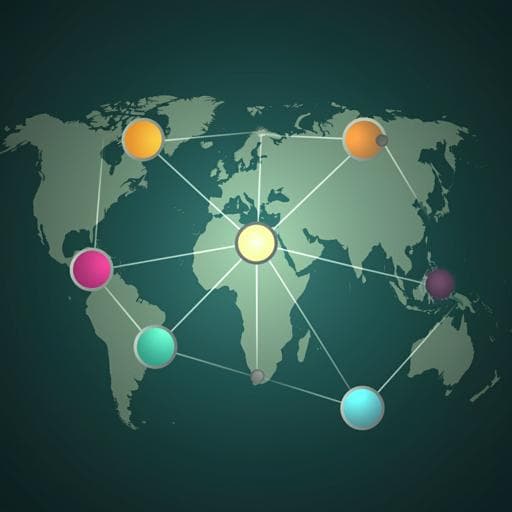
Political Science
Measuring competition between the great powers across Africa and Asia using a measure of relative dispersion in media coverage bias
E. Gooch, S. Goethe, et al.
Discover a groundbreaking measure of great power competition in Africa and Asia, as explored by authors Elizabeth Gooch, Stone Goethe, Nicholas Sobrepena, and Eric Eckstrand. This research reveals the intricacies of media coverage bias among major powers, shedding light on the varying dynamics of national strategies in these regions.
~3 min • Beginner • English
Introduction
The study addresses the question of where and to what extent great power competition (GPC) occurs across African and Asian countries, against a context of perceived US influence decline and rising Chinese and Russian influence. The authors define competition as multiple state actors pursuing the same or connected national interests within the same region. They propose a quantitative, country-level metric of competitiveness based on the coefficient of variation (CoV) of local media coverage ratios for five great powers (United States, China, Russia, India, France) using GDELT news data from 2015–2021. In parallel, they create an independent, narrative-based subregional competition metric from government, think-tank, and academic sources to validate the media-based metric. The importance of the study lies in providing an empirical, comparative measure of GPC from local perspectives over a wide geography, informing debates on global multipolarity and policy strategy.
Literature Review
The conceptual framework integrates international relations, ecology, and economics. From IR, the authors draw on Lake’s conception of competition as a “race” for economic privilege and Copeland’s notion of economic zones. Great powers are defined as nations able to project influence across multiple regions (Toynbee). They include China, Russia, the US, India (for South Asia), and France (for many African states). From ecology, they analogize Gause’s competitive exclusion principle (CEP): dominance implies low competition; parity among actors implies high competition. From economics, they consider critiques of competition definitions (McNulty) and the effect of increasing numbers of competitors on competition intensity. They discuss how dominance by one actor (e.g., US in South Africa) can imply low measured competition despite economic value. The narrative review also synthesizes recent great power pursuits across subregions (East, West, Central, North, and Southern Africa; Central, South, Southeast, and Western Asia) across interest areas such as arms, security cooperation, energy, petroleum, maritime control, infrastructure, and trade/FDI, forming the basis of the GPC-Narrative scoring.
Methodology
Data source and curation: The study uses the GDELT 2.0 dataset (March 2015–March 2021), which provides globally scraped, article-level event mentions with metadata including actor nationality, event location, and source outlet. The authors subset events to those occurring within African or Asian countries and involving actors from the US, China, Russia, India, or France. They identify local press sources by manually verifying outlet contact addresses; outlets headquartered outside the country of interest (e.g., US or Europe) are excluded to capture local press perspectives. They note GDELT’s proprietary collection and coding algorithms could introduce unknown biases.
Media ratio and competition metric (GPC-CoV): For each country i and great power j, they compute the media ratio r_ij = x_ij / Σ_j x_ij, where x_ij is the count of local-press articles about actors from great power j in country i. In Russia and India (home states of two powers), domestic-actor mentions are omitted to focus on foreign-actor coverage, yielding four-power ratios (max competition at 25% each). Competition is operationalized as low dispersion of these ratios: equal shares across powers imply high competition; dominance by one power implies low competition. They use the coefficient of variation (CV = standard deviation of the ratios divided by their mean) to create a country ranking; lower CV indicates higher competition. Countries are visualized via heatmaps of media ratios and CV-based ranks.
Narrative-based metric (GPC-Narrative): Independently, the authors synthesize literature to code, by subregion, which powers pursue eight interest areas: (1) arms sales/tech, (2) security cooperation/bases/operations, (3) use of force/peacekeeping/status quo maintenance, (4) energy facilities/technology/training, (5) fossil fuel extraction, (6) maritime control/naval presence, (7) infrastructure/transport/telecom, (8) trade/FDI/commercial interests. For each interest in each subregion, they compute a competition score as 2^n if n>0 (where n is the number of powers active in that interest), otherwise 0; subregional totals sum across interests to yield GPC-Narrative.
Validation and analysis: They aggregate the country-level GPC-CoV to subregions and assess correlation with GPC-Narrative, finding a weak negative correlation (r ≈ −0.31), consistent with construction (lower CV = greater competition; higher narrative score = greater competition). They also illustrate an application by modeling the predicted mean emotional tone of local-press articles toward Chinese actors as a function of competition intensity and (a) distance from China, (b) tone toward American actors, and (c) tone toward Russian actors, visualized via contour plots.
Key Findings
- Constructed GPC-CoV ranks 88 African and Asian countries by competition intensity. Most competitive: Egypt, Seychelles, Oman, Uzbekistan, Mauritius, Angola. Least competitive: Israel, Kenya, Swaziland (Eswatini), Liberia, Somalia, Central African Republic.
- GPC-CoV reveals widespread US dominance across over half of the countries; Russia and China dominate in relatively few places (e.g., Syria, Tajikistan, Turkmenistan; Laos, Namibia, Maldives). Example: Nigeria (large economy) appears less competitive due to strong US dominance, whereas Angola is more competitive.
- Narrative subregion scores (GPC-Narrative): East Africa (68), Southeast Asia (62), Central Asia (56), North Africa (54), South Asia (52), West Africa (46), Central Africa (46), Western Asia/Middle East (42), Southern Africa (24).
- Validation: Aggregated GPC-CoV and GPC-Narrative are weakly and negatively correlated (r ≈ −0.31), supporting that the media-based metric reflects multi-power pursuit patterns captured in literature.
- Press tone application: (1) Only countries with extremely high competition and moderately far distance from China report very positively on Chinese actors; countries near China report negatively regardless of competition. (2) Tone toward Chinese and American actors is strongly positively correlated across all competition levels (no clear interaction). (3) Tone toward Chinese and Russian actors shows interaction: in low-competition countries, Chinese tone is roughly neutral regardless of Russian tone; in high-competition countries, tones toward Chinese and Russian actors are strongly and directly correlated.
Discussion
The findings indicate that competition, as captured by dispersion in local media attention among great powers, varies substantially across African and Asian countries and is not synonymous with economic size or resource endowments. The GPC-CoV metric identifies contexts where multiple powers have comparable presence—opportunities for influence contestation—while highlighting many cases of US dominance. The weak negative correlation with the independently derived GPC-Narrative supports the validity of the media-based approach despite differing constructions and levels of analysis. The application to media tone suggests public/media receptiveness to Chinese activities depends on both geographic distance and competitive context, and that perceptions of Chinese and American activities move together regardless of competition level, whereas perceptions of Chinese and Russian activities are contingent on competition intensity. The results contribute an empirical, scalable measure of GPC grounded in local perspectives, relevant for strategic planning and academic debates on multipolarity and influence.
Conclusion
The study introduces and validates a country-level measure of great power competition (GPC-CoV) based on local media coverage dispersion among the US, China, Russia, India, and France across Africa and Asia (2015–2021). It ranks countries from high to low competition (e.g., Egypt and Angola vs. Central African Republic), showing extensive US dominance but also pockets of competitive parity. An independently constructed subregional narrative metric (GPC-Narrative), based on literature-coded interests, correlates negatively with the media-based measure as expected, lending support to construct validity. The index’s utility is demonstrated by linking competition intensity to local press tone toward Chinese actors and its interactions with geography and tones toward American and Russian actors. The authors argue that such empirical measures can inform strategic choices about where competition is most active and where influence efforts may be more impactful (e.g., potentially competitive countries like Cambodia). Future research could refine data inputs (e.g., improved media-source validation), extend temporal and geographic scope, disaggregate interests within countries, and further test relationships between competition and public attitudes or outcomes.
Limitations
- Data generation opacity: GDELT’s proprietary scraping and coding algorithms may introduce unknown biases in event identification, actor attribution, and source selection, potentially affecting downstream measures.
- Coverage and scope: Analysis is limited to Africa and Asia and to March 2015–March 2021 (GDELT 2.0), which may omit earlier dynamics or other regions.
- Source classification: Identifying “local press” relied on manual verification of outlet locations; misclassification could affect country-level ratios.
- Metric construction: GPC-CoV aggregates all interest areas; it cannot disaggregate competition by sector (e.g., arms vs. infrastructure) as done in the narrative metric. The CV values are comparative (for ranking) rather than intrinsically interpretable magnitudes.
- Special cases: In Russia and India, domestic coverage is omitted to focus on foreign actors, creating differing denominator structures that may affect comparability despite using CV.
- Validation granularity mismatch: GPC-CoV is country-level, while GPC-Narrative is subregional; aggregation may attenuate correlations.
Related Publications
Explore these studies to deepen your understanding of the subject.







